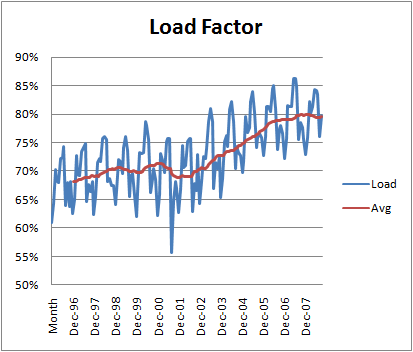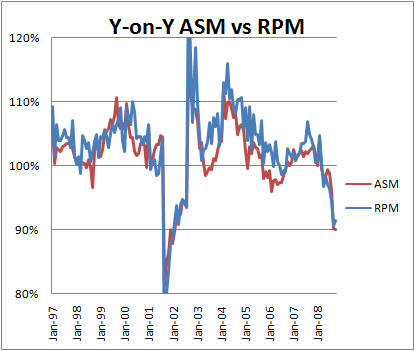Why
Fewer People are Flying part 2
Reasons 3 - 5 : Because there are
fewer seats and better alternatives
|
|
Part of the reason
passenger numbers have stopped growing and started to
shrink? The airlines have cut back on flights, and
many of the remaining flights are already full.
Not even the cleverest
airline exec can sell more seats on a plane that is already
full.
Part two of a three part
series on why fewer people are flying - please
also visit
1.
Facts, figures, fares and fees
2. Full and fewer Flights, better alternatives
3.
The total unpleasantness of air travel today |
There's been a massive change
in airline flight operations over the last few years, with
steadily increasing numbers of passengers per flight, reaching
levels that were previously considered to be both impossible and
ill advised.
Could the reason that passenger
numbers have stopped growing and started to fall back be
insufficient flights and too few available seats to support the
passenger numbers that otherwise might potentially appear?
Reason 3 : Full Flights
Limit Airlines' Ability to Accept More Passengers
Here's a statement of
the obvious : If you're flying a full plane, you can't grow
your passenger numbers, no matter how hard you try.
There has been an enormous
increase in the average 'load factor' on flights over the last
few years. The load factor is the percentage of seats on a
plane that are sold.
For the longest time,
airlines averaged load factors comfortably below 70%; indeed the
rule of thumb for airlines was to price a flight so that it
would break even at about a 60% load factor and anything above
this represented profit. Conventional wisdom in the
industry maintained that it was somewhere between impossible and
ill-advised to have load factors averaging much above 70%
because in such cases, with an average load factor of 70%, this
meant some flights were full or nearly full, with the result
that airlines would sometimes be turning business away.
It also meant that the
airlines had a more stressed system, with less ability to absorb
passengers from other flights in cases of cancellations or
delays.
Now look at this chart
showing the load factor, both monthly (interesting to see the
seasonal swings) and a twelve month moving average

Average load factors have
grown from an operationally sound level averaging in the high
60's with swings up to as much as 75%, and reached an
unthinkable average level of 80% with monthly swings exceeding
85%.
This means two things.
First, from the passenger/customer experience, flights are full,
and therefore, appreciably less pleasant. Gone are the
days where we could be sure of an empty seat next to us, and now
we consider ourselves lucky to avoid being squashed into the middle seat
ourselves. It seems almost every flight we're on is
100% full, making for longer time to board, more hassle finding
space for carry-on (and with the massive fees for checking
luggage, more people are carrying on more things), and a longer
time to deplane at the other end, to say nothing of a more
cramped and crowded flying experience.
Am I stating the obvious to
say that for this reason alone, flying is massively less
pleasant than it used to be, and we're encouraged to avoid
flying if at all possible?
The second thing this means
is the airlines are limiting the number of passengers they
can carry. Let me explain how it is that when airlines are
averaging (say) 80% full flights, with apparently the ability to
still add more passengers, this is not the case.
While the average
flight load might be 80%, this means that some flights are 60%
full while others are 100% full. Therein lies the problem,
masked by the average number.
Another limiting factor is that if a
person wants to fly somewhere and back home again, they will
typically take at least two flights (of course - one there and
one back), and maybe four or more (if flying through a hub). If
just one of their flights is full and unavailable, and assuming no
other flights at convenient times, this doesn't mean they
simply reduce their travel from four flights to three. It
means they end up cancelling or deferring their entire journey,
even though three of the four flights had availability. A
single full flight has cost the airline four passenger sectors.
Here's a news-flash to the
airline executives : If your plane is full, you can't grow
your passenger numbers any more. Don't blame your lack of
passengers on us. Blame it on yourself and the lack of
seats you now have available to sell.
Which of course leads to :
Reason 4 : Fewer Flights
Mean Fewer Passengers
Here's an interesting
question - which came first? Fewer flights, or fewer
passengers? Are the fewer passengers the result of fewer
flights, or are fewer flights the result of fewer passengers?
Look at this chart which
shows the monthly changes, up or down, in ASM and RPM compared
to the same month the previous year. For the period prior
to 2001, the red line (available airline capacity) sort of
matches the blue line (passengers). Now skip the
'discontinuity' caused by 9/11 and see the clearly apparent
trend since then - the addition of flights has lagged behind the
growing demand for flights. The red line is almost always
lower than the blue line.
Note that these numbers are
a somewhat simplified way of answering this question, but they
give an illustrative if not exact answer.

In any case, the question
isn't as important as it may seem. The key issue is not
which happened first way back when, but rather why the airlines
allowed capacity to be maxed out and didn't add extra flights to
respond to the clear opportunities in the market - either before
or after their current flights started operating 'too full'.
If the airlines are worried
about too few people flying, here's a suggestion - give us some
more flights to travel on.
Reason 5 : Alternatives
to Flying Are Now Cheaper
With a hat tip
acknowledgement to the tougher economic times, let's think what
has happened in the last six months. The price of gas for
our car has more than halved. Most of us were paying
something over $4/gallon in the middle of 2008. By the
end, we were paying something under $2/gallon.
A similar thing has been
experienced by the airlines. They started 2008 with fuel
costs around $2.70/gallon. In July, they were paying up to
$4.25 a gallon, but by the end of the year, their cost was about
$1.35, the first time since early 2005 that jet fuel prices have
been that low.
But the price of air travel
has stayed constant. Actually, no. It hasn't stayed
constant. The airlines have continued to increase fees,
even after July when their fuel costs started plunging back down
(and - get this - have continued to blame the need for their
exorbitant fees on
high fuel costs!). So the total true cost of traveling
somewhere by plane has steadily increased all year, while the
cost of driving has plummeted in the second half of the year.
If you're a family of four
and finding cash a bit shorter now,
you'll think hard and long about paying top dollar to fly somewhere
when the cost savings opens up so much if you take your car
instead.
This is confirmed by holiday
travel statistics from AAA, who projected that the Christmas
season saw only a 1.2% decrease in people traveling by car
(compared to the 9% decrease in air travel).
Interestingly, the AAA estimates there was a small increase
of almost 1% in the number of people traveling by train or bus
over the Christmas period.
These numbers clearly show
that the reduction in travel is not happening consistently
across all forms of travel. It is concentrated primarily
on the airlines.
Part two of a three part
series on why fewer people are flying - please
also visit
1.
Facts, figures, fares and fees
2. Full and fewer Flights, better alternatives
3.
The total unpleasantness of air travel today
Related Articles, etc
|
If so, please donate to keep the website free and fund the addition of more articles like this. Any help is most appreciated - simply click below to securely send a contribution through a credit card and Paypal.
|
Originally published
9 Jan 2009, last update
30 May 2021
You may freely reproduce or distribute this article for noncommercial purposes as long as you give credit to me as original writer.
|

